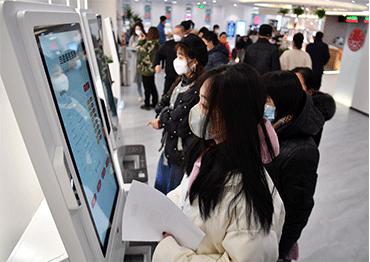This year’s government work report also highlighted the importance of attracting foreign investment. Stressing that “all market access restrictions on foreign investment in the manufacturing sector were lifted,” the report pledged to “ensure national treatment for foreign-funded enterprises in fields such as access to production factors, license application, standards setting and government procurement” in order to “make China a favored destination for foreign investment.”
In the past couple of months, Chinese stocks, especially tech firms, have become a hot prospect for many foreign investors. Fueled by the boom in China’s tech companies, the Hong Kong Tech Index surged by 36 percent in the past three months as of March 20.
Chinese tech firms have been given various nicknames, such as “Six Little Dragons,” referring to DeepSeek, Unitree Robotics, DEEP Robotics, BrainCo, Game Science and Manycore Tech, and the “Terrific Ten,” referring to the more established firms of Alibaba, Tencent, Meituan, Xiaomi, BYD, JD.com, NetEase, Baidu, Geely and SMIC.
In February, several leading international financial institutions, including Goldman Sachs, Morgan Stanley and Deutsche Bank, expressed bullish views on Chinese tech shares, citing their AI advances.
On February 25, China’s Ministry of Commerce and the National Development and Reform Commission (NDRC), the country’s top economic planner, released an action plan to stabilize foreign investment that includes 20 measures.
According to a report released by the American Chamber of Commerce (AmCham) in South China on February 26, 76 percent of the 316 foreign companies AmCham surveyed said they intend to reinvest in China, with a notable 74 percent of the US companies planning reinvestments, up 11 percentage points year-on-year.
On March 16, officials from the NDRC and the Commerce Ministry arranged a special meeting with representatives from international companies, including Tesla, AstraZeneca and SoftBank, along with a diverse array of industries such as finance and investment, biopharmaceuticals, automotive manufacturing and tourism.
During the meeting, Jiang Yi, director of the policy research office of the NDRC, said that China will soon release the 2025 version of the catalogue of industries that encourage foreign investment, which will include new sectors such as advanced manufacturing, modern services, high-tech industries and environmental protection.
Stressing that China’s development journey has been “extraordinary” in the past year, showing strong resilience and vitality in the economic sector, Jiang said that China’s commitment to “deepening reform and expanding high-standard opening up remains unchanged and will not change.”
For many analysts, this year’s two sessions has inspired greater confidence in China’s economic prospects. “Generally speaking, China’s economy has demonstrated strong resilience and shown notable advantages across various sectors,” Xue said. “With strong macroeconomic policy support, we should remain confident in China’s economic development this year.”

 Old Version
Old Version



